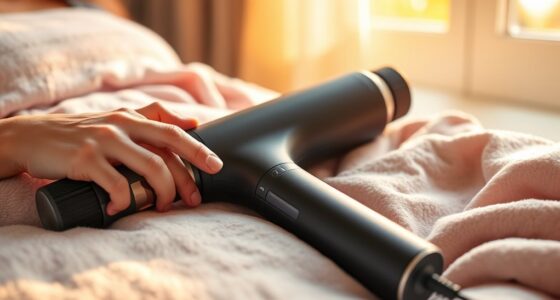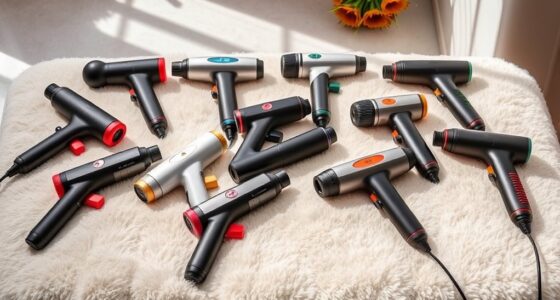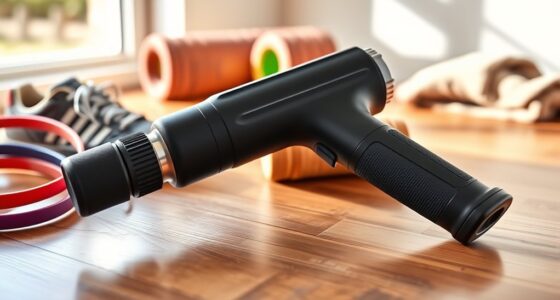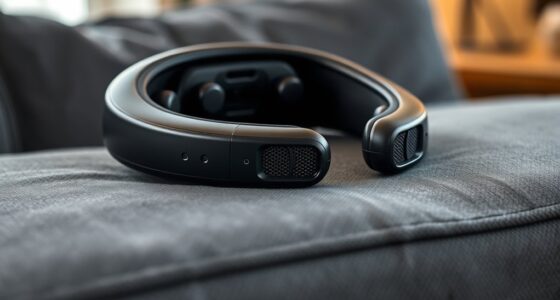If you’re looking for the top astronomy laptops with long battery life, I recommend considering models like the ACEMAGIC 2025 AX16, which offers a 16-inch display and solid performance, a high-performance 15.6-inch model with 16GB RAM, and a lightweight 15.6-inch option great for portability. All these options balance decent battery life with powerful specs, making them suitable for outdoor stargazing. Keep exploring to discover which one best fits your observing needs.
Key Takeaways
- Prioritize laptops with high-capacity batteries (at least 60Wh) for 8+ hours of outdoor stargazing.
- Choose models with energy-efficient processors like Intel N5095 or 12th Gen Intel chips to extend battery life.
- Opt for lightweight, portable designs (under 3.5 lbs) with slim profiles for easy transport during outdoor sessions.
- Reduce display brightness and enable power-saving modes to maximize runtime during extended observations.
- Select laptops with SSD storage and integrated graphics for better efficiency and longer battery performance.
ACEMAGIC 2025 AX16 16.0-inch Laptop with Intel 12th Processor and 512GB SSD
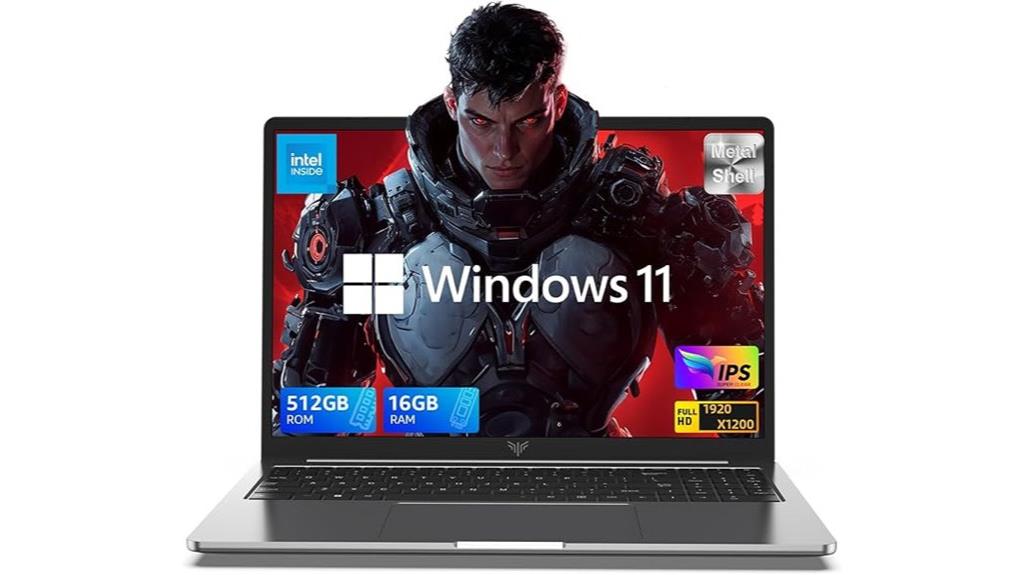
Are you looking for a portable yet powerful laptop to explore the stars? The ACEMAGIC 2025 AX16 is perfect for that. It sports a sleek metal shell and a 16-inch thin-bezel display with 1920×1200 resolution, offering vibrant visuals and wide angles. Weighing just 5.64 pounds and measuring 14.05 x 8.97 x 0.66 inches, it’s easy to carry. Powered by an Intel 12th Gen Alder Lake quad-core processor and 16GB DDR4 RAM, it handles demanding tasks smoothly. Plus, the 512GB SSD ensures fast boot times and ample storage. Pre-installed with Windows 11, it’s a great choice for astronomy enthusiasts on the go.
Best For: users seeking a portable, powerful laptop for demanding tasks and immersive visual experiences on the go.
Pros:
- Sleek metal shell and lightweight design for portability and modern aesthetics
- 16-inch thin-bezel display with vivid colors and wide viewing angles for immersive visuals
- Powered by an Intel 12th Gen Alder Lake quad-core processor with 16GB RAM and fast 512GB SSD for smooth performance
Cons:
- Customer rating of 3.4 out of 5 stars indicates mixed reviews and potential concerns
- Limited to 512GB storage without immediate options for larger capacity unless expanded
- Slightly higher weight compared to ultra-light laptops at 5.64 pounds
15.6″ Laptop Computer with 16GB RAM and 512GB SSD

This 15.6-inch laptop with 16GB RAM and a 512GB SSD is an excellent choice for amateur astronomers who need a portable, high-performance device for stargazing apps, data analysis, or astrophotography editing. Its Full HD IPS display offers crisp visuals with anti-glare protection, reducing eye strain during long nights of observation. Weighing just 3.54 pounds, it’s easy to carry anywhere. Powered by an Intel N5095 processor and integrated graphics, it handles multitasking smoothly. The device also features a backlit keyboard, fingerprint security, and a 4K HDMI port, making it versatile for both work and leisure. Battery life is around five hours, supporting extended stargazing sessions.
Best For: amateur astronomers and students seeking a portable, high-performance laptop for stargazing, data analysis, and astrophotography editing.
Pros:
- High-performance 16GB RAM and 512GB SSD for smooth multitasking and quick data access
- Crisp, anti-glare 15.6″ Full HD IPS display ideal for long observation sessions and detailed visuals
- Lightweight design at 3.54 pounds with versatile connectivity options including a 4K HDMI port and backlit keyboard
Cons:
- Battery life of approximately 5 hours may be limiting for extended outdoor use
- Integrated graphics may not support high-end gaming or intensive graphic tasks
- Availability and pricing may vary across retailers, potentially affecting affordability
15.6-inch Laptop Computer with 16GB RAM and 512GB SSD
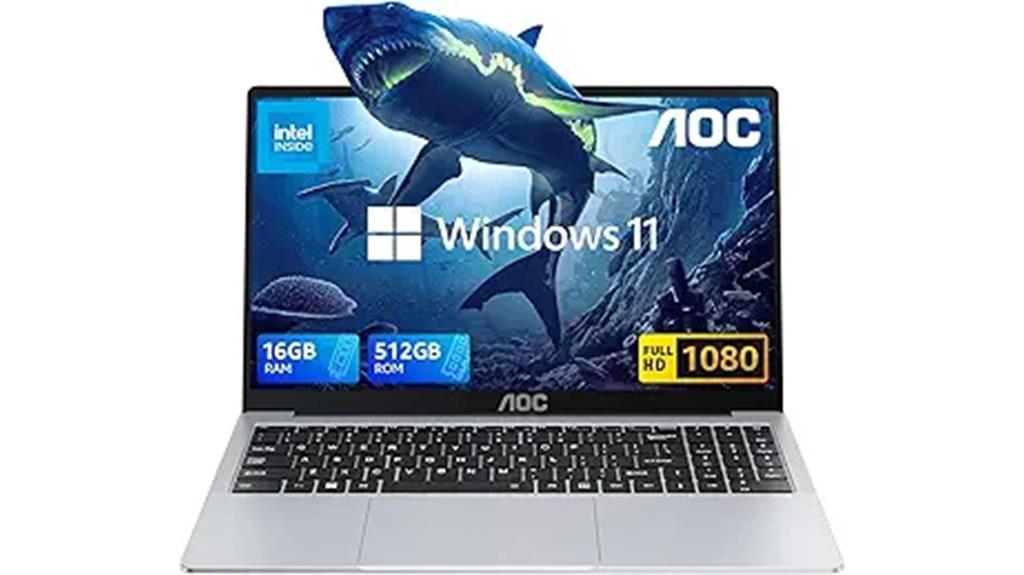
If you’re seeking a compact yet powerful laptop for astronomy, the 6-inch model with 16GB RAM and 512GB SSD might seem tempting, but is it really suitable for detailed star mapping and data analysis? Honestly, a 6-inch screen may be too small for intricate visual work and real-time data review. While it boasts impressive specs like a 16GB RAM, fast SSD, and a lightweight design, the tiny display limits usability. It’s better suited for quick adjustments or on-the-go notes rather than detailed observations or complex calculations. For serious astronomy tasks, a larger, more comfortable screen remains essential.
Best For: professionals and students seeking a portable, high-performance 15.6-inch laptop capable of multitasking, multimedia, and productivity tasks with a focus on color accuracy and connectivity.
Pros:
- Large 15.6-inch Full HD IPS display with immersive color accuracy for detailed work and multimedia viewing
- Powerful 12th Gen Intel N150 processor with 16GB RAM and 512GB SSD for efficient multitasking and fast data access
- Lightweight design weighing only 1.7 kg with extensive connectivity options, including HDMI, Type-C, USB 3.2, and Wi-Fi 6
Cons:
- Battery life of just over 4 hours may be limiting for extended use without charging
- The 15.6-inch size may be less portable for users prioritizing ultra-lightweight devices
- No dedicated GPU, which could affect performance in graphics-intensive applications
Factors to Consider When Choosing Astronomy Laptops With High Battery Life
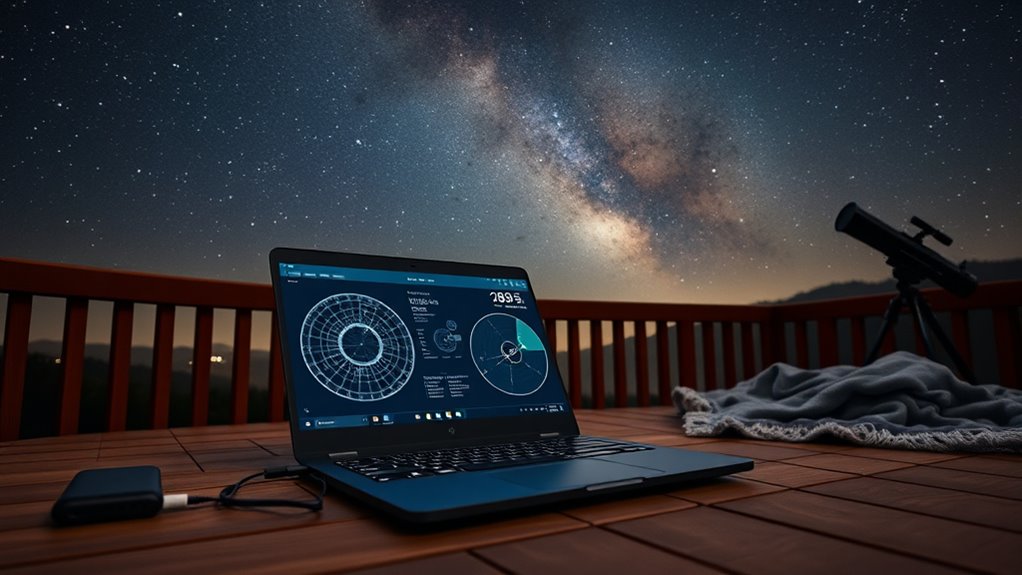
When choosing an astronomy laptop with high battery life, I focus on how long it can realistically last on a single charge and how display brightness affects power use. I also consider power management features and how hardware efficiency and software optimization can prolong that battery life during long observing sessions. These factors help ensure I get reliable performance without constantly searching for an outlet.
Battery Longevity Expectations
Choosing an astronomy laptop with high battery life requires paying close attention to several key factors. Typically, a good battery life means lasting at least 8 to 10 hours on a single charge, which is vital for long stargazing sessions. The battery capacity, measured in watt-hours (Wh), plays an essential role—larger capacity generally means longer usage. Processor efficiency and advanced power management features can also extend runtime, especially during extended observations. Additionally, screen size and brightness settings impact consumption; smaller, energy-efficient displays drain less power. Keep in mind that your usage patterns matter; running intensive software or keeping background processes active can cut battery life considerably. By considering these factors, you can select a laptop that meets your field needs and guarantees uninterrupted stargazing.
Display Brightness Settings
Adjusting your laptop’s display brightness is one of the simplest yet most effective ways to extend battery life during outdoor astronomy sessions. Lowering the brightness reduces power consumption, especially when working in remote areas without easy access to outlets. Most laptops let you manually control brightness through function keys or system settings, so you can quickly optimize for longer use. Many models also feature auto-brightness, which uses ambient light sensors to adjust the screen automatically, balancing visibility and power savings. Reducing the screen brightness from maximum to a moderate level can cut power usage by up to 50%, depending on the device. Maintaining ideal brightness settings ensures you get the most out of your battery during extended observation sessions, making it a key factor to contemplate when choosing a laptop for astronomy.
Power Management Features
Optimizing your laptop’s power management features can substantially extend battery life during long astronomy sessions. Features like adaptive brightness and CPU throttling automatically adjust settings to reduce energy consumption without sacrificing performance. Many laptops include dedicated power-saving modes that tweak system settings to conserve battery when needed, which is especially helpful during extended observations. Enabling sleep or hibernate modes when the laptop is idle can also preserve power effectively. Advanced technologies like Intel SpeedStep or AMD PowerNow! dynamically regulate processor performance, balancing energy efficiency with computing needs. By leveraging these hardware and software optimizations, you can maximize your laptop’s battery life and ensure it lasts throughout your stargazing or data analysis sessions. Power management features are essential in selecting a long-lasting astronomy laptop.
Hardware Efficiency Levels
When selecting an astronomy laptop with high battery life, understanding hardware efficiency levels is essential. The power consumption of components like the CPU, GPU, and storage directly impacts battery longevity. Energy-efficient processors with low TDP ratings help maximize runtime by balancing performance and power draw. Integrated graphics typically use less energy than dedicated GPUs, making them ideal for extended use. Additionally, hardware features such as adaptive brightness and sleep modes further improve efficiency. Upgrading to SSD storage instead of traditional HDDs not only speeds up your system but also reduces power consumption. By focusing on these hardware efficiency factors, you can choose a laptop that conserves energy without sacrificing the performance needed for astronomy tasks, ensuring longer battery life during those long observation sessions.
Software Optimization Techniques
Effective software optimization plays a vital role in extending battery life on astronomy laptops, especially during long observation sessions. By reducing background processes and disabling unnecessary startup programs, I can lower CPU and GPU load, conserving power. Adjusting power management settings like dimming the screen and activating battery saver modes further prolongs usage time. Using lightweight astronomy software designed for efficiency minimizes CPU and memory use, decreasing power consumption. Regularly updating software and drivers ensures optimal performance and energy efficiency, preventing unnecessary drain caused by outdated code. Managing system resources through task scheduling and limiting multitasking during observations helps avoid hardware overload. These techniques, when combined, significantly boost battery life, making my astronomy laptop more reliable for extended fieldwork and night-time observations.
Portability and Weight
Choosing a portable astronomy laptop is essential for outdoor observing, especially if you plan to carry it for long distances. Lighter laptops, under 3.5 pounds, are much easier to transport, reducing fatigue during extended sessions. Compact designs around 14 inches or less provide a good balance between portability and screen size for detailed star maps. Slim laptops under 0.7 inches thick are easier to pack in backpacks or telescope cases, making field setup more convenient. Many portable models feature battery-integrated designs that keep weight manageable while ensuring durability. A lower overall weight minimizes physical strain during long nights of stargazing, making high battery life laptops more practical for mobile use. Prioritizing portability helps you focus on the stars, not your gear.
Usage Patterns and Tasks
If you plan to spend long hours observing or collecting data in the field, considering how your laptop’s battery life aligns with your tasks becomes essential. Tasks like star tracking or astrophotography require laptops with extended battery life to prevent interruptions. I recommend prioritizing models with efficient processors and optimized power management to maximize runtime during long sessions. If you use resource-heavy software like planetarium programs or image processing tools, keep in mind they can drain batteries quickly. Working in remote locations with limited power access makes battery longevity even more critical. Additionally, think about external accessories like drives or peripherals, which can increase power consumption. Selecting a laptop that balances performance with battery efficiency ensures you stay productive without constantly hunting for power sources.
Frequently Asked Questions
How Do Battery Life Tests for Astronomy Laptops Compare?
Battery life tests for astronomy laptops vary depending on the testing methods and usage scenarios. I’ve found that some tests simulate real-world conditions, like running astronomy software or streaming data, which give a better idea of actual battery performance. Others focus on standardized benchmarks, which might not reflect everyday use. Overall, I recommend looking at multiple reviews and real-world tests to gauge how long a laptop truly lasts during your astronomy sessions.
Can External Batteries Significantly Extend Laptop Usage Time?
Yes, external batteries can markedly extend your laptop’s usage time. I’ve used portable power banks that double or even triple my laptop’s battery life, especially during long stargazing nights. Just make certain the power bank has enough capacity and the right connectors. It’s a game-changer for astronomy enthusiasts like me who need reliable power in remote locations. Just remember to carry a compatible charging cable and check the power bank’s voltage.
Are Lightweight Laptops Suitable for Extended Stargazing Sessions?
Lightweight laptops are great for portability, but they might not always be ideal for extended stargazing sessions. I find that they often have smaller batteries, which can run out quickly if you’re using resource-intensive astronomy software or running long observation nights. If you’re planning lengthy sessions, I recommend choosing a lightweight model with a high-capacity battery or carrying an external power source to keep your device running smoothly.
How Does Screen Brightness Affect Battery Longevity During Astronomy?
Screen brightness can drain your battery faster than a supernova burns through fuel. When I keep my display at maximum brightness, my laptop’s battery life takes a nosedive, making long stargazing sessions tricky. Dimming your screen conserves power and extends your session, allowing you to enjoy the night sky longer. So, I always lower my brightness to balance visibility and battery longevity during those epic astronomical adventures.
What Software Optimizations Help Conserve Battery During Star Observation?
I recommend turning off unnecessary background apps and reducing screen brightness to conserve battery during star observation. Using power-saving modes and disabling Wi-Fi and Bluetooth when not needed also helps extend your laptop’s runtime. Additionally, adjusting display settings to lower refresh rates and closing unused programs minimizes power drain. These simple software tweaks make a big difference, so you can enjoy longer, uninterrupted stargazing sessions without worrying about battery life.
Conclusion
So there you have it, folks—your ticket to stargazing without constantly hunting for outlets. Because who needs a romantic dinner when you can have a laptop that outlasts your patience for astronomical mysteries? Remember, the best astronomy laptop isn’t just about long battery life; it’s about pretending you’re a serious scientist while secretly binge-watching space documentaries. Happy stargazing, and may your battery never die when you’re about to spot that elusive comet!


